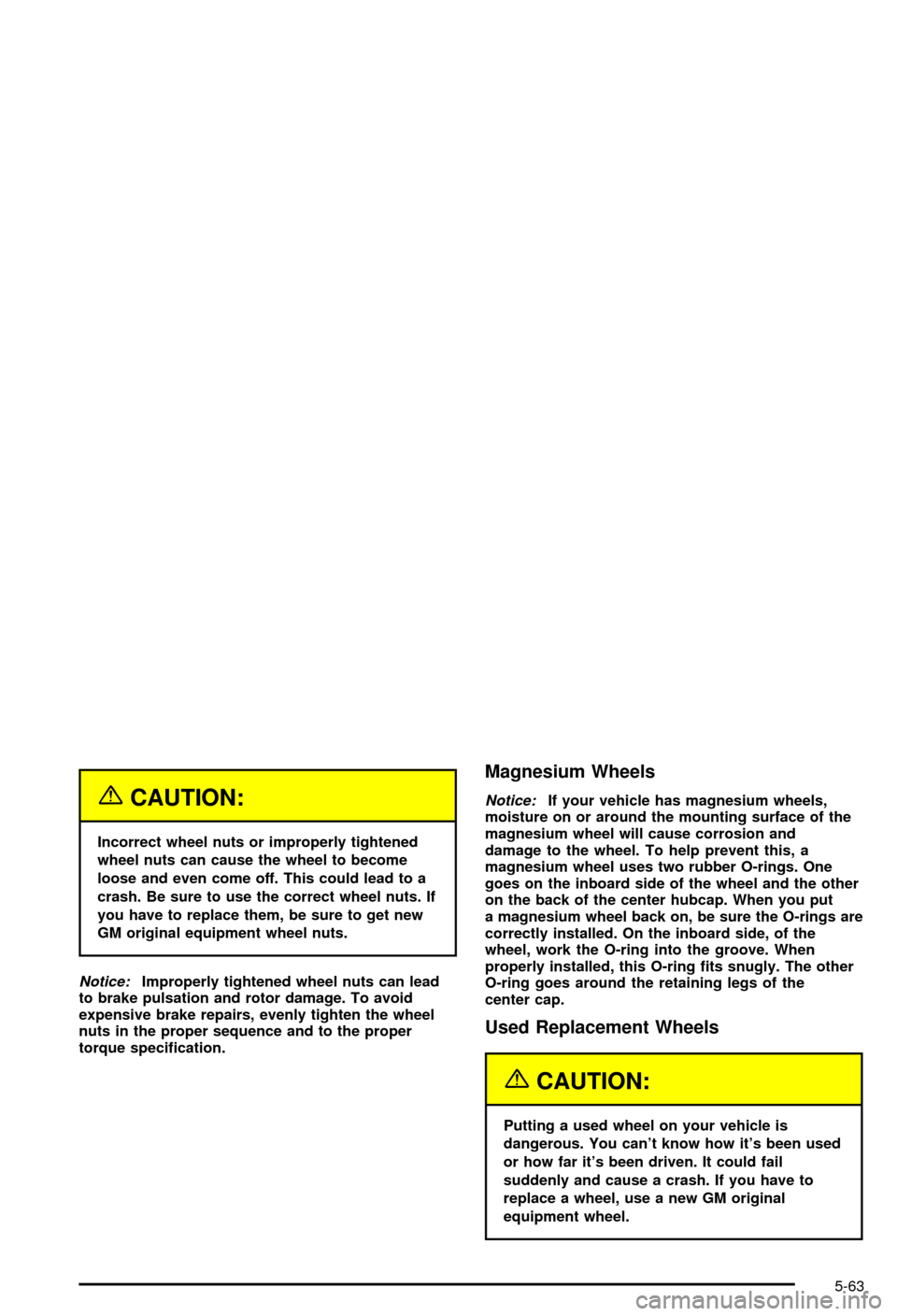2003 CHEVROLET CORVETTE torque
[x] Cancel search: torquePage 82 of 368

NEUTRAL (N):In this position, your engine doesn't
connect with the wheels. To restart when you're already
moving, use NEUTRAL (N) only. Also, use
NEUTRAL (N) when your vehicle is being towed.
{CAUTION:
Shifting into a drive gear while your engine is
ªracingº (running at high speed) is dangerous.
Unless your foot is ®rmly on the brake pedal,
your vehicle could move very rapidly. You
could lose control and hit people or objects.
Don't shift into a drive gear while your engine
is racing.
Notice:Damage to your transmission caused by
shifting out of PARK (P) or NEUTRAL (N) with
the engine racing isn't covered by your warranty.
AUTOMATIC OVERDRIVE (
X): This position is
for normal driving.
THIRD (3):This position is also used for normal driving.
However, it offers more power and lower fuel economy
than AUTOMATIC OVERDRIVE (
X).Here are some times you might choose THIRD (3)
instead of AUTOMATIC OVERDRIVE (
X):
·When driving on hilly, winding roads.
·When going down a steep hill.
SECOND (2):This position gives you more power but
lower fuel economy than THIRD (3). You can use
SECOND (2) on hills. It can help control your speed as
you go down steep mountain roads, but then you
would also want to use your brakes off and on.
If you manually select SECOND (2) when you start the
vehicle, the transmission will drive (and stay) in
second gear. You may use this feature for reducing
torque to the rear wheels when you are trying to start
your vehicle from a stop on slippery road surfaces, or for
preventing the transmission from downshifting into
FIRST (1) in situations where a downshift would
be undesirable.
FIRST (1):This position gives you even more power,
but lower fuel economy, than SECOND (2). You can use
it on very steep hills, in deep snow or mud. If the shift
lever is put in FIRST (1), the transmission won't shift into
®rst gear until the vehicle is going slowly enough.
2-26
Page 89 of 368

Torque Lock (Automatic Transmission)
If you are parking on a hill and you don't shift your
transmission into PARK (P) properly, the weight of the
vehicle may put too much force on the parking pawl
in the transmission. You may ®nd it difficult to pull the
shift lever out of PARK (P). This is called ªtorque
lock.º To prevent torque lock, set the parking brake and
then shift into PARK (P) properly before you leave
the driver's seat. To ®nd out how, see ªShifting
Into PARK (P)º listed previously in this section.
When you are ready to drive, move the shift lever out of
PARK (P)
beforeyou release the parking brake.
If torque lock does occur, you may need to have another
vehicle push yours a little uphill to take some of the
pressure from the parking pawl in the transmission, so
you can pull the shift lever out of PARK (P).
Shifting Out of Park (P)
(Automatic Transmission)
Your vehicle has an automatic transmission shift lock
control system. You have to fully apply your regular
brake before you can shift from PARK (P) when
the ignition is in ON. See
Automatic Transmission
Operation on page 2-24.
As a reminder, you will see a message in the Driver
Information Center (DIC) that will say PRESS BRAKE
BEFORE SHIFT within 15 seconds unless the brake
is pressed.
If you cannot shift out of PARK (P), ease pressure on
the shift lever ± push the shift lever all the way into
PARK (P) and release the shift lever button as
you maintain brake application. Then press the shift
lever button and move the shift lever into the gear
you wish.
2-33
Page 170 of 368

COOLANT OVER TEMP:You will hear four chimes
and the CHECK GAGES telltale will come on when this
message is displayed. To acknowledge the warning,
press the RESET button. After you press the RESET
button, a message will be displayed and you will hear a
chime every minute until this condition changes. If
you do not press RESET, the message will remain on
the digital display until the condition changes.
If the engine coolant exceeds 255ÉF (124ÉC), this
message is displayed. If you have been operating your
vehicle under normal driving conditions, you should
pull off the road, stop your vehicle and turn off the
engine as soon as possible. You can monitor the coolant
temperature with the GAGES button on the DIC or
the engine coolant gage on the instrument panel cluster.
See
Engine Overheating on page 5-26.
REDUCE ENGINE RPM:You will hear four chimes
when this message is displayed. To acknowledge
the warning, press the RESET button. After you press
the RESET button, a message will be displayed and you
will hear a chime every minute until this condition
changes. If you do not press RESET, the message will
remain on the digital display until the condition
changes.
If the engine oil temperature exceeds 320ÉF (160ÉC),
this message is displayed. You should check the engine
coolant temperature and engine oil level. If your
engine is too hot, see
Engine Overheating on page 5-26.Your vehicle may need service, so see your dealer. You
can monitor the oil temperature with the GAGES
button on the DIC.
HIGH TRANS TEMP (Automatic Transmission
Only):You will hear four chimes when this message is
displayed. To acknowledge this warning, press the
RESET button. After you press the RESET button, the
message will be displayed every 10 minutes until
the condition changes. If you do not press RESET, the
message remains on the display until the condition
changes.
If the transmission ¯uid temperature rises above 270ÉF
(132ÉC) or rises rapidly, this message is displayed.
The transmission may shift gears or apply the torque
converter clutch to reduce the ¯uid temperature. Driving
aggressively or driving on long hills can cause the
transmission ¯uid temperature to be higher than normal.
If this message appears, you may continue to drive at
a slower speed. You should also monitor the
transmission ¯uid temperature and allow it to cool to at
least 230ÉF (110ÉC). The transmission ¯uid temperature
can be monitored with the GAGES button on the
DIC. See
Automatic Transmission Fluid on page 5-20.
You should also check the engine coolant temperature.
If it is also hot, see
Engine Overheating on page 5-26.
If the HIGH TRANS TEMP message is displayed during
normal vehicle operation on ¯at roads, your vehicle
may need service. See your dealer for an inspection.
3-58
Page 291 of 368

{CAUTION:
Incorrect wheel nuts or improperly tightened
wheel nuts can cause the wheel to become
loose and even come off. This could lead to a
crash. Be sure to use the correct wheel nuts. If
you have to replace them, be sure to get new
GM original equipment wheel nuts.
Notice:Improperly tightened wheel nuts can lead
to brake pulsation and rotor damage. To avoid
expensive brake repairs, evenly tighten the wheel
nuts in the proper sequence and to the proper
torque speci®cation.
Magnesium Wheels
Notice:If your vehicle has magnesium wheels,
moisture on or around the mounting surface of the
magnesium wheel will cause corrosion and
damage to the wheel. To help prevent this, a
magnesium wheel uses two rubber O-rings. One
goes on the inboard side of the wheel and the other
on the back of the center hubcap. When you put
a magnesium wheel back on, be sure the O-rings are
correctly installed. On the inboard side, of the
wheel, work the O-ring into the groove. When
properly installed, this O-ring ®ts snugly. The other
O-ring goes around the retaining legs of the
center cap.
Used Replacement Wheels
{CAUTION:
Putting a used wheel on your vehicle is
dangerous. You can't know how it's been used
or how far it's been driven. It could fail
suddenly and cause a crash. If you have to
replace a wheel, use a new GM original
equipment wheel.
5-63
Page 320 of 368

Capacities and Speci®cations
The following approximate capacities are given in English and metric conversions.
Please refer to
Part D: Recommended Fluids and Lubricants on page 6-14for more information.
Capacities and Speci®cations
ApplicationCapacities
English Metric
Air Conditioning Refrigerant R134a 1.75 lbs 0.79 kg
Automatic Transmission
Drain and Re®ll 5.0 quarts 4.7 L
Overhaul 10.8 quarts 10.2 L
Cooling System 12.6 quarts 11.9 L
Engine Oil with Filter 6.5 quarts 6.1 L
Fuel Tank 18.0 gallons 68.0 L
Manual Transmission (Overhaul) 4.1 quarts 3.8 L
Wheel Nut Torque 100 lb ft 140Y
All capacities are approximate. When adding, be sure to ®ll to the appropriate level, as recommended in this
manual. Recheck ¯uid level after ®lling
5-92
Page 321 of 368

Engine Speci®cations
Engine VIN Code Transmission Spark Plug Gap Firing Order
LS1 V8 G Automatic 0.060 inch
(1.524 mm)1±8±7±2±6±5±4±3
LS1 V8 G Manual 0.060 inch
(1.524 mm)1±8±7±2±6±5±4±3
LS6 V8 S Manual 0.060 inch
(1.524 mm)1±8±7±2±6±5±4±3
Engine Data
Engine Horsepower Torque Displacement Compression Ratio
LS1 Automatic
Transmission350 @ 5200 rpm 360 @ 4000 rpm 5.7 L 10.1:1
LS1 Manual
Transmission350 @ 5200 rpm 375 @ 4400 rpm 5.7 L 10.1:1
LS6 405 @ 6000 rpm 400 @ 4800 rpm 5.7 L 10.5:1
5-93
Page 367 of 368

Tires.............................................................5-54
Buying New Tires........................................5-59
Chains.......................................................5-64
Extended Mobility........................................5-54
If a Tire Goes Flat.......................................5-68
In¯ation -- Tire Pressure...............................5-56
Lifting Your Corvette....................................5-64
Pressure Monitor System..............................5-57
Rotation.....................................................5-58
Tire and Wheel Inspection............................6-12
Tire In¯ator Kit............................................5-70
Uniform Tire Quality Grading.........................5-60
Wheel Alignment and Tire Balance.................5-61
Wheel Replacement.....................................5-61
To Use The Engine Coolant Heater...................2-23
Top Strap Anchor Location...............................1-31
Top Strap......................................................1-30
Torque Lock (Automatic Transmission)...............2-33
Towing..........................................................4-33
Recreational Vehicle.....................................4-33
Towing a Trailer..........................................4-35
Your Vehicle...............................................4-33
Traction.........................................................4-10
Active Handling System................................4-10
Control System (TCS).................................... 4-9
Control System Warning Light.......................3-36
Limited-Slip Rear Axle..................................4-11
Selective Ride Control..................................4-12
Transmission Operation, Automatic....................2-24
Transmission Operation, Manual........................2-27Transmission..................................................5-20
Fluid, Automatic...........................................5-20
Fluid, Manual..............................................5-20
Transportation Options...................................... 7-8
Trunk/Hatch...................................................2-11
Trunk-Mounted CD Changer.............................3-71
Turn and Lane-Change Signals.......................... 3-6
Turn Signal/Multifunction Lever........................... 3-6
Twilight Sentinel
ž(Optional in United States,
Standard in Canada)....................................3-14
U
Underbody Flushing Service.............................6-11
Understanding Radio Reception........................3-77
Uniform Tire Quality Grading............................5-60
United States ± Customer Assistance.................. 7-4
Unlocking the Theft-Deterrent Feature After a
Power Loss................................................3-76
V
Vehicle Identi®cation........................................5-83
Number (VIN).............................................5-83
Service Parts Identi®cation Label...................5-83
Vehicle Personalization....................................2-55
Memory.....................................................2-55
Vehicle Storage..............................................5-40
13